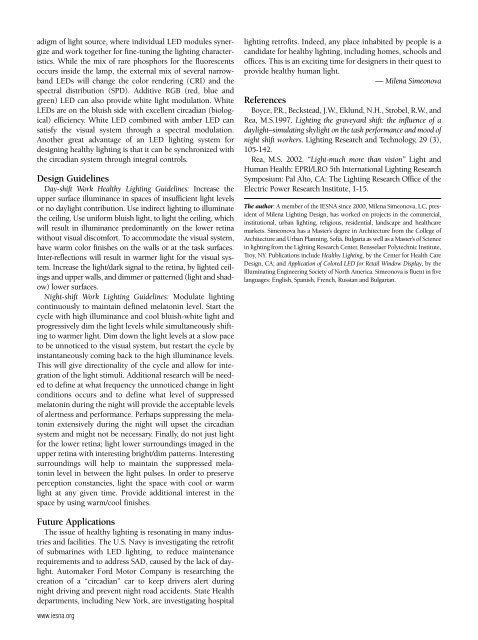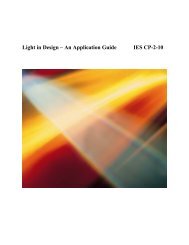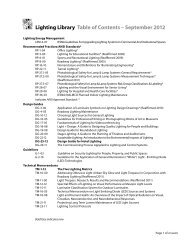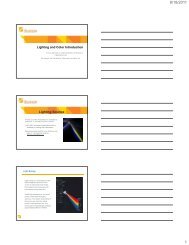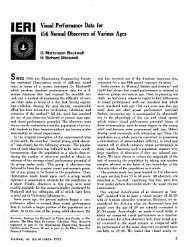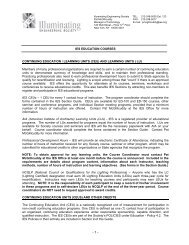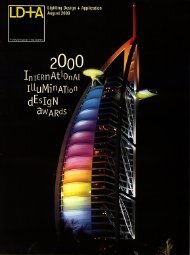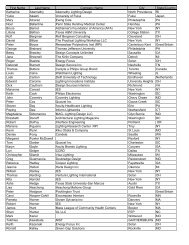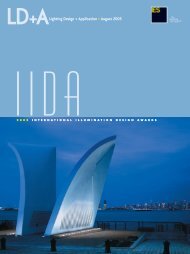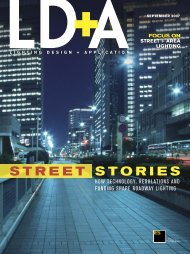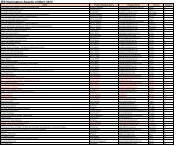time to another. However, timing and duration for thecircadian system are important. The circadian system isbulky and slow in response and even though it’s able tointegrate light stimuli, it needs prolonged time exposureto light. The circadian system will be more responsive tolight at certain times in the 24-hour cycle, usually whenthe lowest body temperature occurs (5 am) or whentransition in melatonin level occurs (6-8 am and 6-9pm). It is most sensitive to light during the night andbecomes progressively numb during the day. Table 1illustrates the timing and duration to light exposure forday-shift and its difference from the night-shift. For dayshift,stable high level of light (light pulse) will boostworker’s alertness and performance. For night-shift,when continuous production of melatonin occurs, periodicallight pulses are the most effective way to communicatewith the circadian system.A study on maintaining graveyard shift workers’ alertnessand performancefound that light could be dimmed down aftera light pulse is administered, thus providing for energy savings.(Boyceat al., 1997). This study also showed how importantis the directionality of the light stimuli and that beginningwith a light pulse and then reducing light is more effective forsuppressing melatonin than starting with low level of light andthen dimming it up.So what are the odds the same lighting will work for boththe circadian and visual systems? Luckily, there are interfacesbetween the systems that allow this to happen. These interfacesare the perceptual constancies and the square law curvefor adaptation to illuminance levels. The IESNA LightingHandbook, 9th Ed., defines the perceptual constancies <strong>as</strong>“fundamental attributes of surrounding objects that are constantover a wide range of lighting conditions.” In this c<strong>as</strong>ewe are interested in two of the attributes, the color constancyand the lightness constancy. The color constancy is preservingthe familiarity with a color (color recognition) underdifferent light sources with different spectral distribution.This will allow the cycled modulation from bluish light (forthe circadian system) to warm light (for the visual system)preserving the features of the surrounding objects. The constancyis the appearance of a piece of white paper when comparedto a piece of black charcoal, even if the charcoal’s luminanceis much higher than the paper’s luminance. The constancyreinforces the other interface and the square law curvefor adaptation to illuminance levels. What the square lawcurve represents is the adaptation of the eye to changes inilluminances. For instance, a me<strong>as</strong>ured illuminance of 50percent of the original illuminance is perceived <strong>as</strong> bright <strong>as</strong>about 70 percent of the original level. This lag in brightnessperception will allow the dimming of light after a lightimpulse h<strong>as</strong> been administered for the circadian systemwithout disturbing the operation of the visual system.Luminaires For Healthy LightingHealthy lighting will require sophisticated controls thatactivate a simultaneous modulation in light intensity andspectral distribution. Traditional energy-efficient lightsources such <strong>as</strong> fluorescent and metal halide will need anarray of dimmable luminaires operating an array of lamps ofdifferent spectral distribution (SPD). This arrangement willresult in expensive and cumbersome lighting systems, however,fine-tuning to the needs of the circadian system will bealmost impossible.A simpler and less expensive lighting system will use LightEmitting Diodes (LED) <strong>as</strong> the light source. LED is a new par-Designing For the BoomersWith the Baby Boomers well into middle age, businessesmust constantly adjust to an aging society. Those who do notmay face:• A loss of customers and valuable employees;• Injuries to customers and staff;• Possible lawsuits;As a result, businesses need to make their workplaces saferand attractive. One of the e<strong>as</strong>iest ways to achieve this is toaccommodate the changes in eyesight <strong>as</strong> one ages.Consultants Judith Adelman and Noel McNaughton offer fourexamples of what business can do to create a well-designedlighting environment:1. A building must be well lit during the day and night.Airports are good examples of well-lit environments. Lightingwithin airport buildings is generally good no matter what time ofday or where you are located in the building. They usually do nothave darkened stairwells and signage is well lit and e<strong>as</strong>ily visible.2. The building’s entrance should not have a dr<strong>as</strong>tic changebetween the lighting inside and outside. Older buildings thathave a foyer often have this problem. Foyers and lobbies thatchange their lighting to adjust to the time of day would meetthis criterion.3. Light sensitive night-lights should be strategically locatedand available to <strong>as</strong>sist staff to adjust to the dark. Anyone whoh<strong>as</strong> had the experience of entering a pitch-black hotel roomwhile trying to find the light switch or awakening in the middleof the night to go to the w<strong>as</strong>hroom knows the advantage of anight-light.4. The flooring colors clearly should demarcate the locationof stairs <strong>as</strong> well <strong>as</strong> changes in elevation or texture. At the sametime, flooring colors do not suggest changing elevations or textureswhen there are none. Long term care facilities, because oftheir experience with the elderly, tend to excel at applying theseconcepts. Floors and stairs usually contr<strong>as</strong>t with the walls andif walls are light colored, stairs should be dark-colored, with slipresistantstrips at their edges. Carpets, if they are used, cancontr<strong>as</strong>t with the floor. These adjustments not only addressvision changes, but also lower the risk of injury.These are just a few of the ways you can pay attention to thevisual needs of those who visit or work on your premises. Yourbusiness can become safer and more attractive to your customersand staff if you take the time to <strong>as</strong>sess your workplaceand make appropriate changes. Often the costs of accommodatingchanges in vision are small when compared to the costof not doing it in the first place.Judith Adelman is a Vancouver- b<strong>as</strong>ed psychologist who providestraining and consulting for organizations. Her focus is onthe aging population and its impact on business and government.She can be reached at Tel: 604-535-2392; or email: jadelman@telus.netVancouver-b<strong>as</strong>ed Noel McNaughton speaks, coaches and consultson managing for the greater good and strategies for midlifeand beyond. Contact her at 1-877-736-1552, or 604-736-1552,or email: noelm@telus.net78 LD+A/May 2003 www.iesna.org
adigm of light source, where individual LED modules synergizeand work together for fine-tuning the lighting characteristics.While the mix of rare phosphors for the fluorescentsoccurs inside the lamp, the external mix of several narrowbandLEDs will change the color rendering (CRI) and thespectral distribution (SPD). Additive RGB (red, blue andgreen) LED can also provide white light modulation. WhiteLEDs are on the bluish side with excellent circadian (biological)efficiency. White LED combined with amber LED cansatisfy the visual system through a spectral modulation.Another great advantage of an LED lighting system fordesigning healthy lighting is that it can be synchronized withthe circadian system through integral controls.Design GuidelinesDay-shift Work Healthy Lighting Guidelines: Incre<strong>as</strong>e theupper surface illuminance in spaces of insufficient light levelsor no daylight contribution. Use indirect lighting to illuminatethe ceiling. Use uniform bluish light, to light the ceiling, whichwill result in illuminance predominantly on the lower retinawithout visual discomfort. To accommodate the visual system,have warm color finishes on the walls or at the t<strong>as</strong>k surfaces.Inter-reflections will result in warmer light for the visual system.Incre<strong>as</strong>e the light/dark signal to the retina, by lighted ceilingsand upper walls, and dimmer or patterned (light and shadow)lower surfaces.Night-shift Work Lighting Guidelines: Modulate lightingcontinuously to maintain defined melatonin level. Start thecycle with high illuminance and cool bluish-white light andprogressively dim the light levels while simultaneously shiftingto warmer light. Dim down the light levels at a slow paceto be unnoticed to the visual system, but restart the cycle byinstantaneously coming back to the high illuminance levels.This will give directionality of the cycle and allow for integrationof the light stimuli. Additional research will be neededto define at what frequency the unnoticed change in lightconditions occurs and to define what level of suppressedmelatonin during the night will provide the acceptable levelsof alertness and performance. Perhaps suppressing the melatoninextensively during the night will upset the circadiansystem and might not be necessary. Finally, do not just lightfor the lower retina; light lower surroundings imaged in theupper retina with interesting bright/dim patterns. Interestingsurroundings will help to maintain the suppressed melatoninlevel in between the light pulses. In order to preserveperception constancies, light the space with cool or warmlight at any given time. Provide additional interest in thespace by using warm/cool finishes.lighting retrofits. Indeed, any place inhabited by people is acandidate for healthy lighting, including homes, schools andoffices. This is an exciting time for designers in their quest toprovide healthy human light.— Milena SimeonovaReferencesBoyce, P.R., Beckstead, J.W., Eklund, N.H., Strobel, R.W., andRea, M.S.1997. Lighting the graveyard shift: the influence of adaylight–simulating skylight on the t<strong>as</strong>k performance and mood ofnight shift workers. Lighting Research and Technology, 29 (3),105-142.Rea, M.S. 2002. “Light-much more than vision” Light andHuman Health: EPRI/LRO 5th International Lighting ResearchSymposium: Pal Alto, CA: The Lighting Research Office of theElectric Power Research Institute, 1-15.The author: A member of the IESNA since 2000, Milena Simeonova, LC, presidentof Milena Lighting Design, h<strong>as</strong> worked on projects in the commercial,institutional, urban lighting, religious, residential, landscape and healthcaremarkets. Simeonova h<strong>as</strong> a M<strong>as</strong>ter’s degree in Architecture from the College ofArchitecture and Urban Planning, Sofia, Bulgaria <strong>as</strong> well <strong>as</strong> a M<strong>as</strong>ter’s of Sciencein lighting from the Lighting Research Center, Rensselaer Polytechnic Institute,Troy, NY. Publications include Healthy Lighting, by the Center for Health CareDesign, CA; and Application of Colored LED for Retail Window Display, by theIlluminating Engineering Society of North America. Simeonova is fluent in fivelanguages: English, Spanish, French, Russian and Bulgarian.Future ApplicationsThe issue of healthy lighting is resonating in many industriesand facilities. The U.S. Navy is investigating the retrofitof submarines with LED lighting, to reduce maintenancerequirements and to address SAD, caused by the lack of daylight.Automaker Ford Motor Company is researching thecreation of a “circadian” car to keep drivers alert duringnight driving and prevent night road accidents. State Healthdepartments, including New York, are investigating hospitalwww.iesna.org


